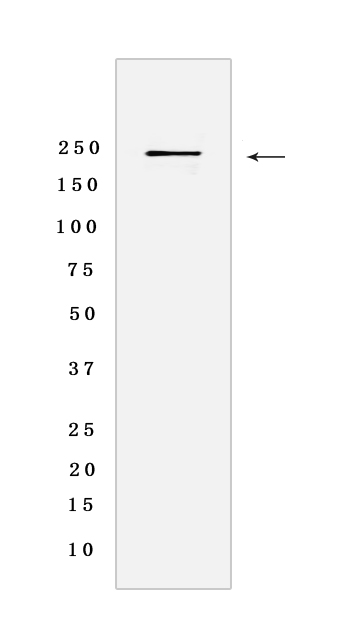SMCHD1 Rabbit mAb [V3HH]Cat NO.: A51847
Western blot analysis of extracts from HepG2 cells lyastes.using SMCHD1 Rabbit mAb [V3HH] at dilution of 1:1000 incubated at 4℃ over night
Product information
Protein names :SMCHD1,KIAA0650,SMHD1_HUMAN,Structural maintenance of chromosomes flexible hinge domain-containing protein 1
UniProtID :A6NHR9
MASS(da) :226,374
MW(kDa) :226 kDa
Form :Liquid
Purification :Protein A purification
Host :Rabbit
Isotype :IgG
sensitivity :Endogenous
Reactivity :Human
- ApplicationDilution
- 免疫印迹(WB)1:1000-2000
- 免疫组化(IHC)1:100,
- The optimal dilutions should be determined by the end user
Specificity :Antibody is produced by immunizing animals with a synthetic peptide of Human SMCHD1.
Storage :Antibody store in 10 mM PBS, 0.5mg/ml BSA, 50% glycerol. Shipped at 4°C. Store at-20°C or -80°C. Products are valid for one natural year of receipt.Avoid repeated freeze / thaw cycles.
WB Positive detected :HepG2 cells lyastes
Function : Non-canonical member of the structural maintenance of chromosomes (SMC) protein family that plays a key role in epigenetic silencing by regulating chromatin architecture (By similarity). Promotes heterochromatin formation in both autosomes and chromosome X, probably by mediating the merge of chromatin compartments (By similarity). Plays a key role in chromosome X inactivation in females by promoting the spreading of heterochromatin (PubMed:23542155). Recruited to inactivated chromosome X by Xist RNA and acts by mediating the merge of chromatin compartments: promotes random chromatin interactions that span the boundaries of existing structures, leading to create a compartment-less architecture typical of inactivated chromosome X (By similarity). Required to facilitate Xist RNA spreading (By similarity). Also required for silencing of a subset of clustered autosomal loci in somatic cells, such as the DUX4 locus (PubMed:23143600). Has ATPase activity,may participate in structural manipulation of chromatin in an ATP-dependent manner as part of its role in gene expression regulation (PubMed:29748383). Also plays a role in DNA repair: localizes to sites of DNA double-strand breaks in response to DNA damage to promote the repair of DNA double-strand breaks (PubMed:25294876, PubMed:24790221). Acts by promoting non-homologous end joining (NHEJ) and inhibiting homologous recombination (HR) repair (PubMed:25294876)..
Subcellular locationi :Chromosome.
IMPORTANT: For western blots, incubate membrane with diluted primary antibody in 1% w/v BSA, 1X TBST at 4°C overnight.


